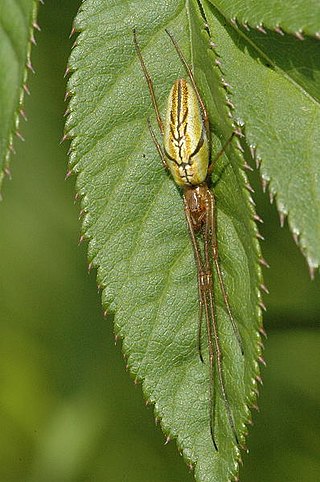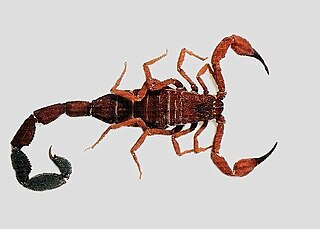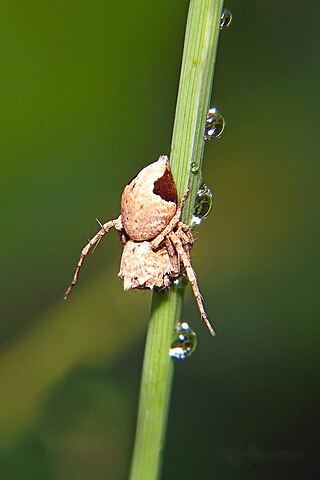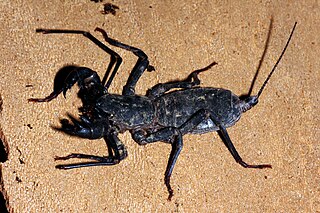
This is a list of all described species of Thelyphonidae, adapted from World Uropygi Catalog in 2022. [1]

This is a list of all described species of Thelyphonidae, adapted from World Uropygi Catalog in 2022. [1]

Uropygi is an arachnid order comprising invertebrates commonly known as whip scorpions or vinegaroons. They are often called uropygids. The name "whip scorpion" refers to their resemblance to true scorpions and possession of a whiplike tail, and "vinegaroon" refers to their ability when attacked to discharge an offensive, vinegar-smelling liquid, which contains acetic acid. The order may also be called Thelyphonida. Both names, Uropygi and Thelyphonida, may be used either in a narrow sense for the order of whip scorpions, or in a broad sense which includes the order Schizomida.

Gasteracantha is a genus of orb-weaver spiders first named by Carl Jakob Sundevall in 1833. Species of the genus are known as spiny-backed orb-weavers, spiny orb-weavers, or spiny spiders. The females of most species are brightly colored with six prominent spines on their broad, hardened, shell-like abdomens. The name Gasteracantha is derived from the Greek gaster (γαστήρ), meaning "belly, abdomen", and akantha (άκανθα), meaning "thorn, spine". Spiny-backed orb-weavers are sometimes colloquially called "crab spiders" because of their shape, but they are not closely related to the true crab spiders. Other colloquial names for certain species include thorn spider, star spider, kite spider, or jewel spider.

Barychelidae, also known as brushed trapdoor spiders, is a spider family with about 300 species in 39 genera.

Tetragnatha is a genus of long-jawed orb-weavers found all over the world. It was first described by Pierre André Latreille in 1804, and it contains hundreds of species. Most occur in the tropics and subtropics, and many can run over water. They are commonly called stretch spiders in reference to their elongated body form and their ability to hide on blades of grass or similar elongated substrates by stretching their front legs forward and the others behind them. The name Tetragnatha is derived from Greek, tetra- a numerical prefix referring to four and gnatha meaning jaw. Evolution to cursorial behavior occurred long ago in a few different species, the most studied being those found on the Hawaiian islands. One of the biggest and most common species is T. extensa, which has a holarctic distribution. It can be found near lakes, river banks or swamps. Large numbers of individuals can often be found in reeds, tall grass, and around minor trees and shrubs.

Mastigoproctus is a genus of whip scorpions. Native to the tropical forest regions of northern South America, these whip scorpions can reach a length of up to 9 centimetres (3.5 in) and can weigh over 30 grams (1.1 oz). Despite popular belief, they are not venomous as, like all other whip scorpions, they do not possess venom glands.

Tityus is a large genus of thick-tailed scorpions, the namesake of its subfamily Tityinae. As of 2021, Tityus contains more than 220 described species distributed in Central America and South America, from Costa Rica to Argentina. Species in the genus Tityus have been studied for hundreds of years, long before the taxonomic classification was put in place. Tityus tend to be of medium size for scorpions, roughly 50 to 70 millimeters long. They are dark brown or red in color, and can exhibit sexual dimorphism. They can live in a variety of environments, ranging from urban to arid mountains to the Amazon Rainforest. Tityus scorpions are best known for their venom and potent sting. The genus contains several dangerously venomous scorpions, the best known of which is the Brazilian yellow scorpion, T. serrulatus. Its venom can cause severe illness, and in the young, old and infirm even death. Some experts have argued that the genus as a whole may be paraphyletic, which could explain the knowledge gaps related to Tityus.

Hypoctonus is a genus of Thelyphonid whip scorpions, first described by Tamerlan Thorell in 1888.

Phlogiellus is a genus of tarantulas that was first described by Reginald Innes Pocock in 1897. They are found throughout Asia and Papua New Guinea, including Indonesia, the Philippines, Papua New Guinea, China, Myanmar, Malaysia, Borneo, Thailand, the Solomon Islands and Taiwan. Phlogiellus is part Latin and part Greek, the first part being "φλóξ φλoγóϛ", meaning flame, the second part being "ellus" which is a latin diminutive suffix.

Hamataliwa is a genus of lynx spiders that was first described by Eugen von Keyserling in 1887.

Thelyphonus is the type genus of whip scorpions or 'vinegaroons' in the subfamily Thelyphoninae, with species found in Southeast Asia.

Typopeltis is an Asian genus of whip scorpions or 'vinegaroons' and currently the only member of subfamily Typopeltinae.

Thelyphonellus is a genus of Thelyphonid whip scorpions, first described by Reginald Innes Pocock in 1894.
Bowie is a genus of Ctenidae that was described by Peter Jäger in 2022. The genus was named after the English singer-songwriter and actor David Bowie and currently encompasses 107 species, 55 of which were named after elements from David Bowie's musical catalogue.